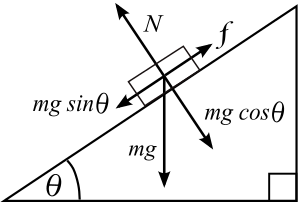An object with a mass of #14 kg# is on a plane with an incline of # - pi/3 #. If it takes #12 N# to start pushing the object down the plane and #8 N# to keep pushing it, what are the coefficients of static and kinetic friction?
1 Answer
If angle of inclination is
#mu_s = 0.678#
#mu_k = 0.645#
(see explanation regarding angle)
Explanation:
We're asked to find the coefficient of static friction

We'll call the positive
There is no net vertical force, so we'll look at the horizontal forces (we WILL use the normal force magnitude
We're given that the object's mass is
Since the angle is
#-(pi)/3# , this would be the angle going down the incline (the topmost angle in the image above). Therefore, the actual angle of inclination is
#pi/2 - (pi)/3 = ul((pi)/6#
The formula for the coefficient of static friction
#f_s >= mu_sn#
Since the object in this problem "breaks loose" and the static friction eventually gives way, this equation is simply
#color(green)(ul(f_s = mu_sn#
Since the two vertical quantities
#n = mgcostheta = (14color(white)(l)"kg")(9.81color(white)(l)"m/s"^2)cos(pi/6) = color(orange)(ul(119color(white)(l)"N"#
Since
#color(green)(f_s) = mgsintheta + 12# #"N"#
#= (14color(white)(l)"kg")(9.81color(white)(l)"m/s"^2)sin(pi/6) + 12color(white)(l)"N" = color(green)(80.7color(white)(l)"N"#
The coefficient of static friction is thus
#mu_s = (f_s)/n = (color(green)(80.7)cancel(color(green)("N")))/(color(orange)(119)cancel(color(orange)("N"))) = color(red)(ulbar(|stackrel(" ")(" " 0.678" ")|#
The coefficient of kinetic friction
#color(purple)(ul(f_k = mu_kn#
It takes
#color(purple)(f_k) = mgsintheta + 8# #"N"#
#= 68.7color(white)(l)"N" + 8# #"N"# #= color(purple)(76.7color(white)(l)"N"#
The coefficient of kinetic friction is thus
#mu_k = (f_k)/n = (color(purple)(76.7)cancel(color(purple)("N")))/(color(orange)(119)cancel(color(orange)("N"))) = color(blue)(ulbar(|stackrel(" ")(" " 0.645" ")|#
